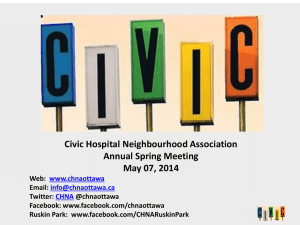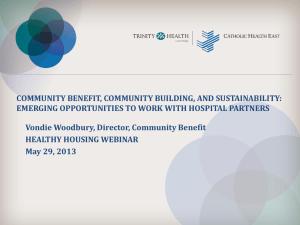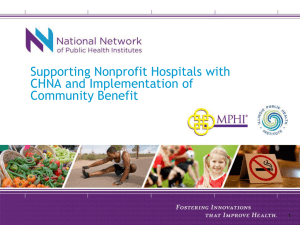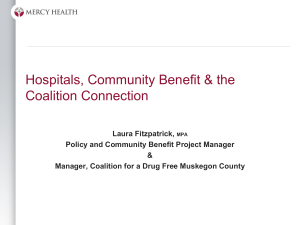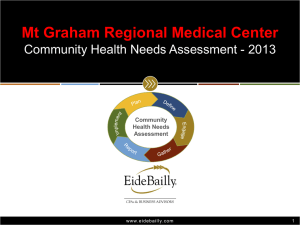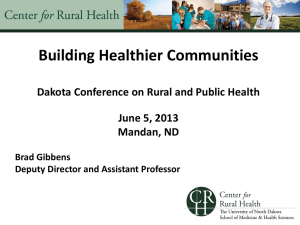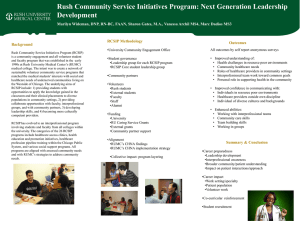Applications
advertisement
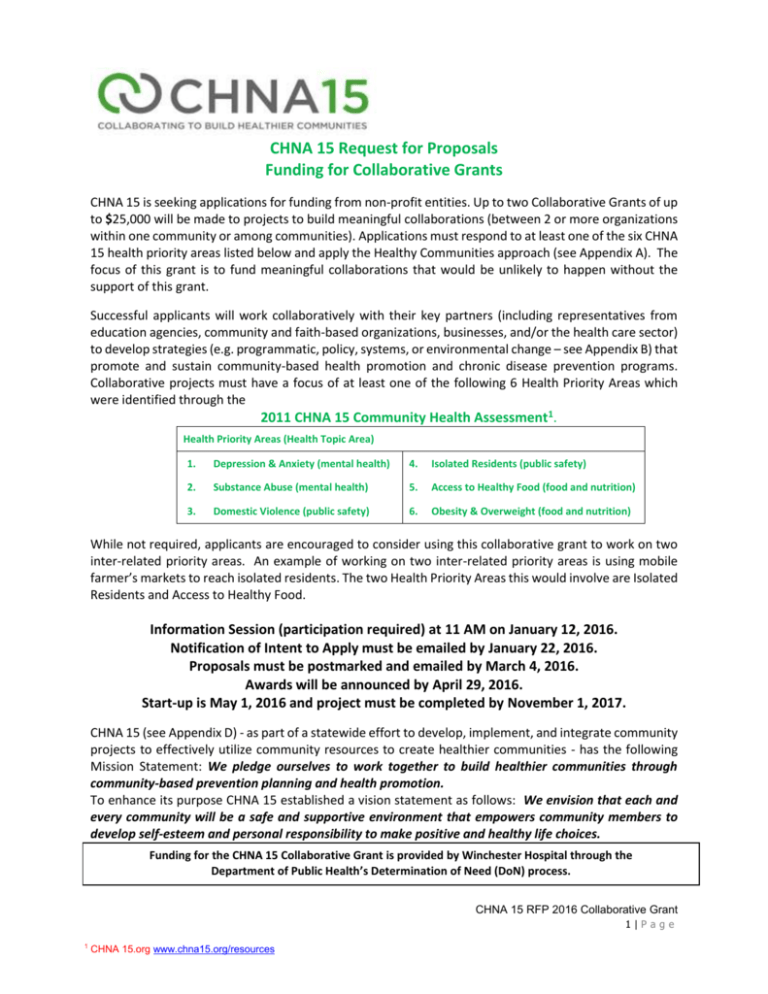
CHNA 15 Request for Proposals Funding for Collaborative Grants CHNA 15 is seeking applications for funding from non-profit entities. Up to two Collaborative Grants of up to $25,000 will be made to projects to build meaningful collaborations (between 2 or more organizations within one community or among communities). Applications must respond to at least one of the six CHNA 15 health priority areas listed below and apply the Healthy Communities approach (see Appendix A). The focus of this grant is to fund meaningful collaborations that would be unlikely to happen without the support of this grant. Successful applicants will work collaboratively with their key partners (including representatives from education agencies, community and faith-based organizations, businesses, and/or the health care sector) to develop strategies (e.g. programmatic, policy, systems, or environmental change – see Appendix B) that promote and sustain community-based health promotion and chronic disease prevention programs. Collaborative projects must have a focus of at least one of the following 6 Health Priority Areas which were identified through the 2011 CHNA 15 Community Health Assessment1. Health Priority Areas (Health Topic Area) 1. Depression & Anxiety (mental health) 4. Isolated Residents (public safety) 2. Substance Abuse (mental health) 5. Access to Healthy Food (food and nutrition) 3. Domestic Violence (public safety) 6. Obesity & Overweight (food and nutrition) While not required, applicants are encouraged to consider using this collaborative grant to work on two inter-related priority areas. An example of working on two inter-related priority areas is using mobile farmer’s markets to reach isolated residents. The two Health Priority Areas this would involve are Isolated Residents and Access to Healthy Food. Information Session (participation required) at 11 AM on January 12, 2016. Notification of Intent to Apply must be emailed by January 22, 2016. Proposals must be postmarked and emailed by March 4, 2016. Awards will be announced by April 29, 2016. Start-up is May 1, 2016 and project must be completed by November 1, 2017. CHNA 15 (see Appendix D) - as part of a statewide effort to develop, implement, and integrate community projects to effectively utilize community resources to create healthier communities - has the following Mission Statement: We pledge ourselves to work together to build healthier communities through community-based prevention planning and health promotion. To enhance its purpose CHNA 15 established a vision statement as follows: We envision that each and every community will be a safe and supportive environment that empowers community members to develop self-esteem and personal responsibility to make positive and healthy life choices. Funding for the CHNA 15 Collaborative Grant is provided by Winchester Hospital through the Department of Public Health’s Determination of Need (DoN) process. CHNA 15 RFP 2016 Collaborative Grant 1|Page 1 CHNA 15.org www.chna15.org/resources Proposal Narrative We encourage thorough but concise responses. (See Appendix C for Definition of Terms referred to in RFP.) 1. Project Description: 10 Points a. Provide a shared statement of project purpose collaboratively crafted by all involved partners. This should include why you feel that a collaborative approach is the most effective way to get at this issue. b. Provide a description of how the collaboration was formed, and how working together will move this project forward. c. State the CHNA health priority area(s) you are addressing, and the strategies you will use to address this/these health priority area(s). Describe your anticipated impact and how you will measure success. d. Which one (or more) of the following activities does your project include: Direct Service Prevention Education Policy Change Other: ____________ 2. Need: 15 Points a. Using data from the CHNA 15 Health Assessment and Fact Sheets, and assessment or planning data (e.g. town planning, etc.), provide justification for the need for this project. Include the target population that will be impacted by your project (age – indicate adults, youth elders; race, ethnicity, socioeconomic status) and the community(ies) that will be impacted by your project. If relevant, describe the policy or system gap that project will address. b. Briefly describe how this project addresses the identified need. 3. Goals and Objectives: 25 Points (See Attachment 2) We encourage you to thoughtfully articulate the steps of the project in a concise manner. 4. Collaboration and Sustainability: 30 Points a. Complete the Collaboration Chart. (See Attachment 3) b. Describe and address any current or anticipated challenges to the collaboration. c. How will collaboration sustain the project after the funding period? How will the project continue? Please explain. d. Submit signed Letters of Commitment from two collaborators reflecting an understanding of the project. Letters should indicate what relationship the writer has to the project and specifically what role they agree to have in the project during and after the funding period. 5. Healthy Communities: 5 Points Select the Healthy Community Principle (See Appendix A) that best reflects the intent of your project and describe how your project aligns with that Principle. 6. Budget: 15 Points (See Attachment 4) Complete the Budget and Budget Justification Form. Contact for questions or clarification: Randi Epstein, CHNA 15 Coordinator, at CHNA15Coordinator@gmail.com. CHNA 15 RFP 2016 Collaborative Grant 2|Page CHNA 15 2016-2017 COLLABORATIVE GRANT Attachments Attachment 1: CHNA 15 2016-2017 Collaborative Grant Cover Page Attachment 2: Goals and Objectives Charts Attachment 3: Collaboration Chart Attachment 4: CHNA 15 Collaborative Grant Budget Form and Justification Attachment 5: CHNA 15 Collaborative Grant Agreement CHNA 15 RFP 2016 Collaborative Grant 3|Page Attachment 1 CHNA 15 2016-2017 COLLABORATIVE GRANT COVER PAGE SUBMISSION DATE: ____________________________ PROJECT TITLE: _____________________________________________________________________________ PROJECT DESCRIPTION:____________________________________________________________ __________________________________________________________________________ LEAD AGENCY/ ORGANIZATION :_________________________________________________________________ CONTACT PERSON: ___________________________________________________________________________ PARTNER ORGANIZATIONS/COMMUNITIES INVOLVED IN THE COLLABORATION (PLEASE ADD LINES AS NECESSARY): PARTNER ORGANIZATION/COMMUNITY A:_________________________________________________________ PARTNER ORGANIZATION/COMMUNITY B:_________________________________________________________ PARTNER ORGANIZATION/COMMUNITY C:_________________________________________________________ FOCUS AREA: PLEASE PUT A CHECK TO THE LEFT OF THE FOCUS AREA(S) YOU WILL ADDRESS: Health Priority Areas (Health Topic Areas) 1. Depression & Anxiety (mental health) 4. Isolated Residents (public safety) 2. Substance Abuse (mental health) 5. Access to Healthy Food (food and nutrition) 3. Domestic Violence (public safety) 6. Obesity & Overweight (food and nutrition) LEAD AGENCY/ ORGANIZATION STREET ADDRESS:__________________________________________________ CITY:_____________________ STATE:_____ ZIP: _________ PHONE:(___)______________________________ FAX: (___)_____________ EMAIL:_____________________________ WEBSITE:_________________________ AMOUNT OF FUNDING REQUESTED: $______________FEDERAL TAX ID #__________________________________ GEOGRAPHIC AREA SERVED BY PROJECT:_____________________________________________________________ HAS YOUR AGENCY RECEIVED ADDITIONAL CHNA 15 FUNDING TOWARD THIS PROJECT? ____YES ____ NO IF YOUR ORGANIZATION HAS A FISCAL AGENT/CONDUIT OTHER THAN THE APPLICANT NAMED ABOVE, PLEASE COMPLETE NAME OF FISCAL AGENT/ CONDUIT: ______________________________________________________________________________________________ NAME OF FISCAL CONTACT PERSON: ______________________________________________________________________________________________ ADDRESS: ________________________________________________________________________________________________________________ CITY:__________________________________________ PHONE: (____)___________________________ STATE:__________ ZIP CODE: ___________________________ FAX: (___)__________________________ EMAIL:_________________________________________ CHNA 15 RFP 2016 Collaborative Grant 4|Page Attachment 2 Goals and Objectives Chart Use 10 point font in chart. Timeframe: For the timeframe below, list month and year (e.g. 8/16-10/16) SMART Goals: We ask for SMART goals below. SMART goals are: S – Specific, M- Measureable, A- Attainable, R-Relevant, T-Time-bound. Number of goals to be determined by applicant. Timeframe Example 3/16-11/16 Goal 1 (SMART): By November 2017, recommendations for mobile farmer’s market sites are presented to the following Smalltown decision makers for approval: Mayor’s office, Smalltown housing authority, Smalltown Department of Public Works, etc. Activities: Review census data and work with partners to collect input from residents to identify mobile farmer’s market sites. Draft proposal for each new site. Meet with individual site decision makers (for example, housing authority) to present proposal for mobile farmer’s market site. Measureable criteria for success: Demonstrated support for new farmer’s market sites through data collected from site residents. Tailored proposals are crafted for each new site. Presentations are made to decision makers CHNA 15 RFP 2016 Collaborative Grant 5|Page Timeframe Goal 1 (SMART): Activities: Measureable criteria for success: Timeframe Goal 2 (SMART): Activities: Measureable criteria for success: Timeframe Goal 3 (SMART): Activities: Measureable criteria for success: CHNA 15 RFP 2016 Collaborative Grant 6|Page Timeframe Goal 4 (SMART): Activities: Measureable criteria for success: Timeframe Goal 5 (SMART): Activities: Measureable criteria for success: Attachment 3 Collaboration Chart Use 10 point font in chart *One collaborator much be identified as lead CHNA 15 RFP 2016 Collaborative Grant 7|Page Attachment 4 Organization: lead* and partners. Please list lead in first row and partners in subsequent rows. Contact Person Clearly define the role of each partner in implementing this project Unique Strengths partner brings to the collaboration Clearly define the role of each partner in sustaining this project Indicate whether this is a NEW or PREEXISTING collaborator CHNA 15 Collaborative Grant Budget Form Itemize all expenses and summarize all revenue and in-kind support for the project Line Item* Amount Requested in Application Name of Lead: Name of Partner 1: Name of Partner 2: In-Kind (source and Amount) and Other Sources Name of Partner 3: Total Project Costs Name of Partner 4: (add columns to the right as needed) Staff CHNA 15 RFP 2016 Collaborative Grant 8|Page Fringe Contract Services Travel/ Supplies Equipment Agency Overhead Other Expenses Total *Definitions are listed on next page. Partner: Indicate organizations actively involved in discussion and development of project. Staff: Indicate number of hours to be applied to this project and hourly rate. Fringe: If applicable. (Check with your agency for how this is calculated and include a breakdown of included charges.) Contract Services: Identify contractor and number of hours. Capital Expenses: Capital expenses include equipment purchases. Capital Expenses may not exceed 10% of requested budget unless justification is provided as to why additional capital expense funds are needed for project success AND a clear plan for ongoing sustainability, maintenance and storage is presented. Agency Overhead: May not exceed 7% of requested budget. Other Expenses: List and explain In Kind: Indicate source and amount of donated goods and services provided by both partners and non-partners. CHNA 15 RFP 2016 Collaborative Grant 9|Page Collaborative Grant Budget Justification The budget justification must explain the relevant details of each line item. Justification should not include program details not identified elsewhere in your proposal. If needed, additional space, not to exceed three pages, may be used. CHNA 15 RFP 2016 Collaborative Grant 10 | P a g e Attachment 5 CHNA 15 Collaborative Grant Agreement If awarded a CHNA 15 Collaborative Grant, we agree to the following: Agreement A To ensure that at least one person representing our project will attend each CHNA 15 General Meeting to share achievements and updates. Agreement B To submit o A Progress Report by February 1, 2017 (template to be provided). Second payment will be made after Progress Report is received. o A Summary Report (template to be provided), plus evaluation and year-end itemized expense sheet, to the CHNA 15 Coordinator by November 1, 2017. To complete the project with all funds spent by November 1, 2017. Should there be unused funds, they will be returned to CHNA 15. To display and discuss the project at CHNA 15 Showcase in the spring of either 2017 OR 2018 – to be determined by grantee. If project is unable to proceed as specified in the application, the organization should contact the CHNA 15 Coordinator as soon as possible and submit an addendum for proposed change. The CHNA 15 Steering Committee will consider the proposal. Continued funding is not an automatic guarantee. Completion and other reporting requirements would remain, as specified in the original application. To include the following statement in all funded project descriptions, products, and related publicity: This project is funded through the CHNA 15 DoN funds from Winchester Hospital. Project Title:_________________________________________________________________ Signature of Authorized Signatory (lead agency):____________________________________ Date:_______________________________________________________________________ Lead Agency:_________________________________________________________________ CHNA 15 RFP 2016 Collaborative Grant 11 | P a g e CHNA 15 2016-2017 Collaborative Grant Appendices Appendix A Healthy Communities Principles Appendix B Policy, Systems and Environmental Changes Appendix C Definition of Terms Appendix D CHNA 15 Information Appendix E Information Session Announcement and Important CHNA 15 Collaborative Grant Dates Appendix F Eligibility and Assessment Criteria Appendix G Instructions for Submission of Responses CHNA 15 RFP 2016 Collaborative Grant 12 | P a g e Appendix A Healthy Community Focus and Healthy Community Principles CHNA 15 programming and funding efforts focus on establishing a broader, more comprehensive approach to developing healthier communities. Healthy Communities is an approach to understanding and improving health and well-being built on decades of work and the thinking of individuals and organizations around the world. The Healthy Communities concept facilitates new collaborations and brings together a variety of community members to identify shared visions and to create new projects. CHNA Members are encouraged to work toward creating healthier communities in each of the twelve CHNA 15 communities, between or among organizations, or between CHNA 15 member towns. Within Healthy Communities efforts, health is not merely access to healthcare and the absence of disease, but strengthening positive social, mental, physical, economic and environmental conditions conducive to health and well-being. The focus is deliberately broad to encompass the ideals of CHNA 15 as well as a member’s agency’s mission. A healthy community is defined as one that supports the health and welfare of its members by following the Healthy Community Principles as listed below. Healthy Community Principles Source: Darvin Ayre, Gruffie Clough, Tyler Norris Principals, Community Initiatives, LLC. Communities across the nation are using a variety of change models and planning processes to work together to achieve their vision of improved health. Regardless of approaches taken to meet their challenges, the following principles are guiding the most successful initiatives. A broad definition of "health" Health is not just the absence of disease. Health is defined broadly to include the full range of quality of life issues. It recognizes that most of what creates health is lifestyle- and behavior-related. Other major factors are genetic endowment and the socio-economic, cultural and physical environment. Health is a by-product of a wide array of choices and factors, not the simply the result of a medical care intervention. A broad definition of "community" By using as broad a definition as possible of what makes up a community, individuals and partnerships can address their shared issues in the most fruitful way possible. Communities are inclusive and can be based on faith, perspective, land and profession, as well as being determined by geographic lines. Shared vision from community values A community's vision is the story of its desired future. To be powerful and inspiring, a community's vision should reflect the core values of its diverse members. A vision is not just a statement on the wall - it is a living expression of shared accountability to priorities. Address quality of life for everyone Healthy communities strive to ensure that the basic emotional, physical and spiritual needs of everyone in the community are attended to. Diverse citizen participation and widespread community ownership All people take active and ongoing responsibility for themselves, their families, their property and their community. A leader's work is to find common ground among participants, so that everyone is empowered to take direct action for health and influence community directions. Focus on "systems change" This is about changing the way people live and work together. It is about how community services are delivered, how information is shared, how local government operates, and how business is conducted. It's about resource allocation and decision making, not just "nice" projects. Build capacity using local assets and resources This means starting from existing community strengths and successes and then investing in the enhancement of a community's "civic infrastructure." By developing an CHNA 15 RFP 2016 Collaborative Grant 13 | P a g e infrastructure that encourages health, fewer resources need to be spent on "back end" services that attempt to fix the problems resulting from a weak infrastructure. Benchmark and measure progress and outcomes Healthy communities use performance measures and community indicators to help expand the flow of information and accountability to all citizens, as well as to reveal whether residents are heading toward or away from their stated goals. Timely, accurate information is vital to sustaining long-term community improvement. CHNA 15 RFP 2016 Collaborative Grant 14 | P a g e Appendix B Policy, Systems and Environmental Changes We recognize that policy, systems, and environmental changes may involve more than the 18 months specified in this grant. Efforts that are clearly linked to, and provide a foundation for the goal of policy, systems or environmental changes, will be considered as well. The following definitions are derived from the CHANGE Action Guide (see the glossary of terms in the Center for Disease Control and Prevention’s Healthy Communities Program CHANGE Action Guide for more information)1. Systems change: A change that impacts all parts of an organization, institution or system. It often includes changes in policies. For an example of systems change, see the Success Story example B in Appendix C titled “From Farms to Lunch Trays: Island Schools enjoy healthier foods all day long.” Environmental Change (Environment): Environmental Change can include physical changes to the environment or changes to social or economic factors in order to influence behavior. For an example of environmental change, see the Success Story in example C in Appendix C titled “Safely Connecting School Children to Spaces to Play.” Policies: Rules, including procedures, protocols, regulations or laws, created to guide or influence behavior. The examples cited above also include some aspect of policy change. 1 CDC Healthy Communities Program CHANGE Action Guide http://www.cdc.gov/healthycommunitiesprogram/tools/change/pdf/changeactionguide.pdf Accessed July 19, 2013. CHNA 15 RFP 2016 Collaborative Grant 15 | P a g e Appendix C Definitions of Terms2 Lead: The lead is responsible for overseeing the grant, and making sure that the project is moving along with team. The lead is also the primary contact person for the CHNA with respect to questions and reporting. Funding is given to the lead, and then is dispersed according to the proposal. The lead has ultimate responsibility for the grant. Partner: All organizations involved in the development and implementation of the project. Goal: The goals state in broad terms what you want to accomplish. They incorporate the purpose and the outcomes. Objective: Objectives state in measurable terms the desired outcomes of the project. Outcome: An outcome objective describes a change or a result. Activity: An activity is what the people who deliver the program do: provide counseling, teach classes, create websites, make art, etc. OR what the people who receive program services or participate in programs do: attend counseling sessions, go to class, use websites, make art, etc. An activity is a task, a method, an approach, an ACTION. Sustainability3: The continuation of community health and quality of life benefits over time 2 achieved through the availability of other resources necessary to implement the work, or through other strategies. SMART Goals: SMART goals are: S – Specific, M - Measureable, A - Attainable, R - Relevant, T-Time-bound. Definitions of “Lead, Goal, Objective, Outcome, and Activity” are from a Grant writing training conducted by Cynthia Barger for the Regional Center for Healthy Communities (Metrowest). 3 Sustainability Toolkit, Center for Civic Partnerships 2 CHNA 15 RFP 2016 Collaborative Grant 16 | P a g e Appendix D Website: www.chna15.org CHNA 15 is one of 27 Community Health Networks across Massachusetts created by the Department of Public Health in 1992. Active since that time, CHNA 15 is a partnership between the Massachusetts Department of Public Health, Regional Center for Healthy Communities, residents, hospitals, local service agencies, schools, businesses, boards of health, municipalities, and other concerned citizens who work together through local collaborations to: identify health needs of member communities, find ways to address those needs, and improve the social and physical health of the community. CHNA 15 is composed of citizens from Acton, Bedford, Boxborough, Burlington, Carlisle, Concord, Lexington, Lincoln, Littleton, Wilmington, Winchester and Woburn. Participation is open to those interested in joining others to work toward the goal of healthier communities. Recent CHNA 15 activities include the following: Completion of a CHNA-wide Community Health Needs Assessment to determine priority areas of need as well as assets, strengths and resources existing in our communities that focus on those needs. Results of the assessment drive interventions and funding allocations. Panel presentations at Healthy Community Resource Forums focusing on community needs as identified by the Community Health Assessment and by members FY’2015 Community Trainings including: Adult Mental Health First Aid, Youth Mental Health First Aid and Tips and Tricks for Grant-writing Awards of 20 FY’2015 Grants totaling $93,540.07 including: o $35,846.17 awarded in 6 Mini Grants to area agencies o $45,000 awarded in 3 Collaborative Grants o $3,483.90 awarded in 6 individual & agency scholarships for Professional Development o $9,210 awarded for 5 Capacity Building Grants CHNA 15 activities are funded by Lahey Clinic, Mount Auburn Hospital, and Winchester Hospital through the Department of Public Health’s five-year Determination of Need (DoN) process. CHNA 15 members and associates network and share ideas with people with similar interest in building healthier communities, gain knowledge about a range of health related issues and topics, participate in designing and implementing health improvement projects, advocate for health issues that are important to their community, benefit from scholarships and Capacity Building Grants for themselves and their agencies, apply for grants for projects for community physical and social health improvement, and attend and/or provide a variety of trainings designed to enhance & strengthen community work. Anyone interested in becoming involved, wanting information on activities, wishing to be added to our ListServ, or any other opportunities offered by CHNA 15, may contact: Randi Epstein, CHNA 15 Coordinator, at CHNA15Coordinator@gmail.com or visit our website at www.chna15.org. CHNA 15 RFP 2016 Collaborative Grant 17 | P a g e Appendix E Information Session and Important CHNA 15 Collaborative Grant Dates - CHNA 15 CHNA 15 will hold a Collaborative Grant RFP Information Session on Tuesday, January 12, 2016 from 11:00 AM – noon. The session will be held at Minuteman Senior Services, 26 Crosby Drive in Bedford (directions below). The space is wheelchair accessible. Information on the Collaborative Grant RFP and a question and answer opportunity will be provided. It is required that potential applicants attend, including previous CHNA 15 grant recipients. Please bring your copy of the RFP. If you plan to attend the Information Session, RSVP to Randi Epstein, CHNA 15 Coordinator, at CHNA15Coordinator@gmail.com. Directions to Minuteman Senior Services FROM ROUTE 128, NORTH OR SOUTH: Take Exit #32 A-B Middlesex Tpk/Burlington/Lowell onto US-3 N toward #32A/Lowell/Nashua, NH Follow directions below for Route 3 North FROM ROUTE 3, NORTH OR SOUTH: 3 N – Take Exit # 26 (Rte. 62 Burlington/Bedford), towards Bedford. This will be Burlington Road. Follow through set of lights onto Crosby Drive. Follow straight approximately .3 miles and turn left at Crosby Corporate Center 20-26 (blue sign). Take your first left into parking area then an immediate left into the parking lot located directly across from Minuteman Senior Services. 3 S – Take Exit # 26 (Rte. 62 Burlington/Bedford), towards Burlington. At set of lights, turn left onto Burlington Rd. (Rte. 62 East). At the next set of lights, turn left onto Crosby Drive. Follow straight approximately .3 miles and turn left at Crosby Corporate Center 20-26 (blue sign). Take your first left into parking area then an immediate left into the parking lot located directly across from Minuteman Senior Services building. Visitor parking area is located across from our building, there is a pathway in the far corner of the parking lot that leads across the street to our main entrance. MINUTEMAN SENIOR SERVICES (No. 26) building is on the right (once you turn at the Crosby Corporate Center 20-26 blue sign), located across from the main parking area. We share a building with EMC 2 and The Schwabel Company. Important CHNA 15 Collaborative Grant Dates January 12, 2016 January 22, 2016 March 4, 2016 By April 28, 2016 May 1, 2016 February 1, 2017 April 2017 OR April 2018 May 2016 and May 2017 November 1, 2017 Information Session at 11 AM at Minuteman Senior Services. Notification of Intent to Apply must be emailed. Proposals must be postmarked and emailed. Awards announced. Project start up. Recipient awarded 50% of project funds. Mid-project report due. Remaining 50% of project funds awarded upon receipt of mid-project report. Report due for CHNA 15 Showcase 2017 OR 2018 booklet. CHNA 15 Showcase featuring Collaborative Grants and other CHNA 15 funded projects. Collaborative grant recipients will be required to participate in either the 2017 or the 2018 Showcase. Projects must be completed. Summary report, evaluation, and project-end itemized expense sheet due. CHNA 15 RFP 2016 Collaborative Grant 18 | P a g e Appendix F Eligibility and Assessment Criteria Eligibility CHNA 15 is seeking applications for funding from non-profit organizations and/or public entities including service providers, health and community-based organizations and coalitions, municipalities, schools, and communities of faith who are interested in improving community health. Hospitals are not eligible for funding, but are encouraged to participate as partners. Previous recipients of a CHNA 15 Collaborative Grant are not eligible. Previous recipients of all other CHNA 15 grant(s) are eligible. Eligibility Requirements: Applicant must serve people in one or more of the CHNA 15 communities. Collaboration must be demonstrated and a lead agency identified. Lead applicant must be a tax-exempt 501C3 under the IRS code or a public entity. If applicant is not a 501C3 they must have a Fiscal Agent who is a 501C3 or partner with an agency with an IRS designation as a 501C3, a Section 170, or other IRS non-profit designation. Collaborative Grant Application Requirements and Assessment Criteria Budget Exclusions and Requirements: No application may exceed a $25,000 budget request. Capital expenses may not exceed 10 % of the total budget unless justification is provided as to why additional capital expense funds are needed for project success AND a clear plan for ongoing sustainability, maintenance and storage is presented. If agency overhead is included, it may not exceed 7% of the total budget. Grant funds can be spent only on staff and expenses related to the Collaborative Grant project. Proposals will be evaluated against the following Assessment Criteria: Complete numbered responses to all Application Components Likelihood of potential success with project Content and Quality of the proposal – as considered by reviewers: Content is an assessment of whether the applicant has responded to each sub-section of the Question; that is, the presence or absence of the required information. Quality of a response is its degree of excellence. A copy of the Reviewers Proposal Score Sheet will be available at the Information Session on January 12, 2016 and on the CHNA 15 website, www.CHNA15.org, after the Information Session. The Score Sheet is intended to expand your understanding of Content and Quality for each proposal question. CHNA 15 RFP 2016 Collaborative Grant 19 | P a g e Appendix G Instructions for Submission of Responses 1. Attend an Information Session on January 12, 2016 at 11 AM at Minuteman Senior Services. (See Appendix E for details.) It is REQUIRED that potential applicants attend, even if you have previously applied for a CHNA 15 Grant. 2. Submit a Notification of Intent to Apply by email by January 22, 2016. The Intent to Apply may be brief including organizational contact information: e-mail address, phone number, contact person, and community/ies and/or organization(s) your proposal will likely include. 3. Submit both electronic and hard copies of proposal. An emailed copy is due by 5 PM on March 4, 2016. One (1) original copy of your proposal, marked Original, plus five (5) copies must be postmarked by 5 PM on March 4, 2016. Proposals postmarked or received via email after the deadline will not be eligible for review or funding. All applicants will receive notification of receipt of proposals. 4. Applications that do not meet ALL requirements will NOT be considered. No exceptions. Submit Notification of Intent to Apply and proposals via mail and email to: Randi Epstein, CHNA 15 Coordinator, 59 Bonwood Road, Needham, MA 02492 and CHNA15Coordinator@gmail.com. Proposals must be written on plain 8 ½ x 11 inch paper, single-spaced, twelve point Arial font, and single-sided with one-inch margins. A 10 point Arial font may be used for the charts in Questions 3, 4, and 7. Your response to proposal narrative questions must be numbered and correspond to the numbered/ lettered format. (2a, 2b, etc.) Application Requirement Checklist Completed CHNA 15 Collaborative Grant Cover Page as the first page of submitted proposal Project narrative with responses to questions 1-6 Completed Budget Form and Justification. 3-page limit. Signed CHNA 15 Collaborative Grant Project Agreement Documentation of Tax Exempt Status or, if applicable, verification of designated Fiscal Agent and 501C3 of that agent No more than two signed Letters of Commitment from community collaborators Electronic copy submitted One original and five hard copies of proposal submitted Applications that do not meet ALL of the above requirements will NOT be considered. No exceptions. Unrequested attachments will not be reviewed. Copies of the RFP and all attachments are available at www.chna15.org CHNA 15 RFP 2016 Collaborative Grant 20 | P a g e
